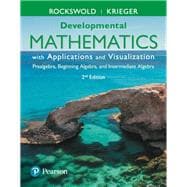For courses in Prealgebra & Beginning Algebra.
The Rockswold/Krieger algebra series fosters conceptual understanding by developing concepts in context through the use of applications, multiple representations, and visualization. By seeing the concept in context before being given the the mathematical abstraction, students make math part of their own experiences instead of just memorizing techniques. The authors believe this approach deepens conceptual understanding and better prepares students for future math courses and life. The new edition continues to bring concepts to life with even more opportunities for students to visualize the math in real-world contexts -- and so, learn key critical-thinking and problem-solving skills -- with new features in the text and MyLab™ Math.
Also Available with MyLab Math.
MyLab™ Math is an online homework, tutorial, and assessment program designed to work with this text to engage students and improve results. Within its structured environment, students practice what they learn, test their understanding, and pursue a personalized study plan that helps them absorb course material and understand difficult concepts. The 2nd Edition continues to help students develop conceptual understanding and bring key concepts to life with content and assignments that reflect the authors’ approach, including new Section Introduction videos and See the Concept videos with assessment. New Skill Builder assignments offer adaptive practice to build students’ foundational skills, and new workspace assignments allow students to show their mathematical reasoning as they progress step-by-step, with specific feedback at each step in the problem-solving process that adjusts to their path.
Note: You are purchasing a standalone product; MyLab™ & Mastering™ does not come packaged with this content. Students, if interested in purchasing this title with MyLab & Mastering, ask your instructor for the correct package ISBN and Course ID. Instructors, contact your Pearson representative for more information.
If you would like to purchase both the physical text and MyLab & Mastering, search for:
0134772393 / 9780134772394 Developmental Mathematics with Applications and Visualization: Prealgebra, Beginning Algebra, and Intermediate Algebra plus MyMathLab -- Access Card Package, 2/e
Package consists of:
013476840X - Developmental Mathematics with Applications and Visualization: Prealgebra, Beginning Algebra, and Intermediate Algebra
0134442784 - Developmental Mathematics with Applications and Visualization: Prealgebra, Beginning Algebra, and Intermediate Algebra -- Life of Edition Student Access Card










